The physical change types are defined depending on the phase transition process, which converts the substance’s physical properties. The article discusses about the physical change types, which are listed below:
Read more about the Physical Change Properties.
Dissolution or Dissolving
When we pour solid salt into water liquid, the salt switches its state from solid to liquid into the water and becomes a different solution. The process responsible for converting the salt’s state is named “dissolution” and depend on solubility of solid.
The salt act as a solute, which dissolves into the solvent to produce a different solution. The water liquid act as a solvent that can dissolve the solute. Even the salt is dissolved into water, its chemical formula (NaCl) remains the same in the water.
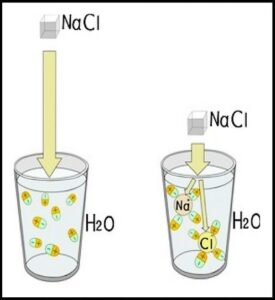
Dissolution of Salt (credit: shutterstock)
Melting or Thawing
When we heat a solid substance like metal, glass, etc., it increases the substance’s internal heat. Every substance has its melting point. Therefore, on the continuous heat, the substance’s internal heat goes beyond its melting point, increasing the energy of its internal particles.
The internal particles move away from each other, increasing the interatomic distance. Therefore, the solid substance melted to form a liquid.
Boiling
Every liquid has its boiling point. Hence, if we continue the heating to liquid, its internal heat approaches beyond its boiling point, contributing more energy to its internal particles. Because of the rise in their interatomic distance due to constant heat, the liquid state boiled to become a gaseous vapor.
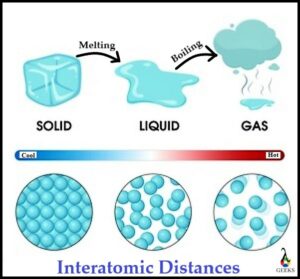
Melting and Boiling by Heating
Read more about Physical Change Heat Examples.
Evaporation
Like the boiling process, evaporation also turns liquid into gas vapor; but it is due to natural heat only. When we put a water-filled bowl into direct sunlight, we notice the empty boil after a couple of hours, as the water evaporates by sun heat.
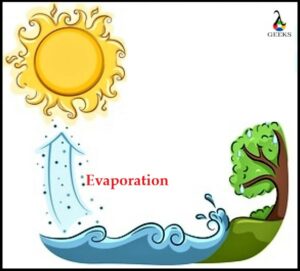
Evaporation by Sun
Such natural heat quickens the internal particles of liquid to move rapidly, which escape them as particles of gas vapor into the atmosphere.
Boiling Vs Evaporation
| Boiling | Evaporation |
| It requires both artificial heat and natural heat. | It requires only the natural heat of the sun. |
| The rate of boiling is fast. | The rate of evaporation is slow. |
| The process happens to the whole liquid mass. | The process only occurs on the surface level of liquid. |
| The vapor pressure of liquid overwhelms the atmospheric pressure. | The vapor pressure of a liquid cannot be able to overcome atmospheric pressure. |
| Hence, a bubbling appears in liquid. | Hence, a bubbling cannot appear in liquid. |
Sublimation or Lyophilisation
It is a unique phase transition process that converts the frozen solid into gas using the natural vacuum heat without transforming it into liquid. Like melting and boiling points, every substance has its triple point – the temperature at which all three states of a substance coexist in equilibrium which cause sublimation of substance.

Sublimation below Triple Point (credit: quora)
The process occurs below the substance’s triple point, corresponding to the lowest temperature at which the substance can exist as a liquid. The sublimation process is a low-temperature dehydration process, also called freeze-drying that preserves the natural food such as vegetables or fruits by first freezing it, decreasing the surrounding pressure, and then transforming the ice by sublimation.
Condensation or Clouding
Like triple point, every substance in the gas state has its dew point – the temperature at which the gaseous air requires to be cooled at constant pressure and the air is not able to handle the water in gaseous form. Therefore the hot vapors from rainwater condense into low temperature of sky to create the clouds. That’s why the condensation called as “clouding“.

Condensation of Clouds (credit: shutterstock)
During condensation, the internal particle of gaseous vapors drops the energy of heat when reaching the cold surfaces, converting gaseous vapors into liquid. The hot vapors condense on cold surfaces like mirrors of showers or steel cover placed on a pan while cooking; to form tiny water droplets.
Vaporization
It is the physical change type that turns solid or liquid into gas vapor. Depending on conversion between states, it is subdivided into three other types: boiling, evaporation, and sublimation, as all three processes obtain gas as the final state.
Out of three types, the sublimation process turns solid into a gas. In contrast, boiling and evaporation involve the conversion of liquid to gas, but the difference between both processes is heat difference.
Smoke Formation
When we burn solid substances like wood, paper, coal, etc., they release their energy in heat and turn into two new products such as ash and smoke. That’s why smoke is called the byproduct of fire. Since the substances are carbonaceous, they release carbon-containing compounds in the air throughout their combustion process.
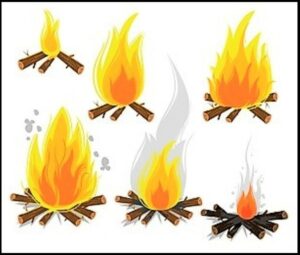
Smoke Formation by Fire (credit: shutterstock)
The smoke is a hot vapor of carbon dioxide gas produced when a combusted substance combines with the air; and it includes all three states of matter such as gases, liquid, and solid carbonaceous compounds.
Solidification or Freezing
Like dew point, every substance in a liquid state has a freezing point. Therefore, when we lower the temperature of a liquid below its freezing point by cooling it, it gradually freezes to become a solid substance. That’s why the process called ‘solidification’.
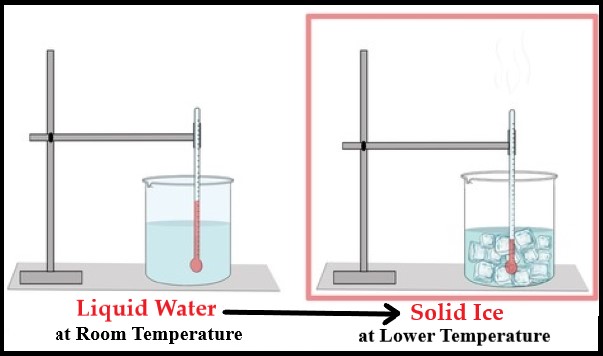
Solidification of Ice (credit: shutterstock)
Cooling the substance, its internal particles drop the energy, which reduces their interatomic distance to form a solid, is called ‘nucleation’. The solidification process is employed to give diverse shapes to the solid. For example, a liquid state such as molten metal or melted wax is solidified to form a solid state of metal or wax of different shapes.
Liquefaction
It is the physical change type that turns gas or solid into a liquid. The conversion between states has subdivided the liquefaction process into three other types: melting, heating, and condensation; as all three processes obtain liquid as the final state. But the difference between all three processes is heat difference.
The gases can be liquefied by cooling or condensation. That means gas can be transformed into a liquid state when it is cooled below its boiling point. For example, gaseous nitrogen liquefied or condenses to form a nitrogen solution.
The solid can be liquefied by heating or melting. That means a solid can transform into a liquid state when it is heated above its melting point. For example, solid coal is liquefied or melted to yield liquid fuels.
Frost Formation
The frost formation is similar to the deposition process, where liquid and gas are deposited into a cooled surface to produce a solid. The process is a combination of solidification of water liquid and condensation of gas vapor.
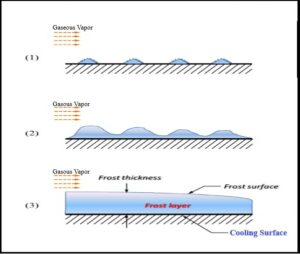
Frost Formation (credit: researchgate)
When the temperature of the solid substance decreases to the freezing point of water, and the dew or condensation point of the adjacent air on surrounding, the layer of ice develops on the solid substance. Therefore, we can recognize the frost or icing on the window panes and grass in the winter season. Since the process is naturally occurring, its rate is slow.
Also Read:
- Is sliding friction static
- Stable equilibrium example
- What is frictionless surface
- When an equilibrium is a static equilibrium
- Wet friction
- What is the law of reflection
- What are natural resources
- Why do deep sea creatures often have bioluminescent parts
- Fixed pulley examples
- Why are there different types of mirrors

Hello, I’m Manish Naik completed my MSc Physics with Solid-State Electronics as a specialization. I have three years of experience in Article Writing on Physics subject. Writing, which aimed to provide accurate information to all readers, from beginners and experts.
In my leisure time, I love to spend my time in nature or visiting historical places.
Looking forward to connecting you through LinkedIn –